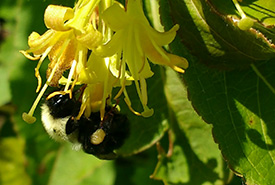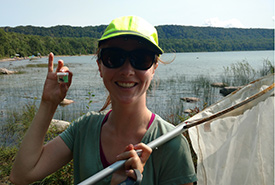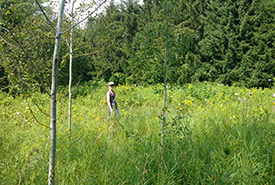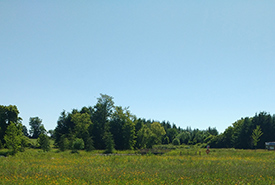Buzzing down the house: An update

Bumble bee (Photo by Amanda Liczner)
This is an update to a post I wrote last year. The data has now been analyzed, and the results are ready for sharing.
We commonly hear that bees are in decline and that we need to save them because they are important pollinators of crops and other plant species. But how can we help bees?
First, it is important to point out that not all bees are at risk of becoming extinct. For example, the European honeybee is not at risk of extinction, but some of our native pollinators could face extinction without conservation measures.
Second, we need to address the threats that these species are facing. For bumble bees, declines are happening due to a combination of factors, including habitat loss, climate change and disease spread from managed bee species.
Related blog posts
My project focused on determining the habitat requirements for two bumble bee species that are in decline in southern Ontario: yellow-banded bumble bee and American bumble bee.

My project focused on determining the habitat requirements for two bumble bee species that are in decline in southern Ontario. (Photo courtesy of Amanda Liczner)
Ensuring there is enough high-quality habitat is important for any species, as habitat contains all the resources needed for a species’ survival. But bumble bee habitat is not well known. Without knowing what makes up the habitat for a particular species, it is very difficult to conserve and protect that species.
Generally, bumble bees need food, a place to nest and somewhere to survive the winter. Food for bumble bees is pollen and nectar, which is collected from flowers, but we know little about their nesting or overwintering needs. Some bumble bees nest underground, such as in rodent burrows. Others may nest right on the ground’s surface, under the plant cover. It isn’t clear where bumble bees overwinter, except that queens bury themselves in the soil at depths of two to 15 centimetres.
I set out with a research team during spring and summer 2017 to survey locations where there was a recent sighting of yellow-banded bumble bee and American bumble bee. Together, we surveyed 25 sites across southern Ontario, including the Nature Conservancy of Canada’s (NCC’s) Backus Woods and Lake Erie Farms properties. We measured variables thought to be important in determining bumble bee habitat. These included the amount of flowering plant species, number of animal burrows, presence of decaying logs and vegetation cover.

I set out with a research team during spring and summer 2017 to survey locations where there was a recent sighting of yellow-banded bumble bee and American bumble bee. (Photo courtesy of Amanda Liczner)
Now, I have some exciting new results from this work to share! We found that landscape-scale habitat variables, such as the amount of forest, agriculture or urban green space in an area, were more important than those on a local scale, such as flower cover, the number of flowering plant species and animal burrow density, for determining habitat for these two bumble bee species. This may be because bumble bees can fly relatively long distances and make use of resources in surrounding areas, especially if they become scarce in one area but not in another.
Habitat preferences for both bumble bee species differed. Yellow-banded bumble bees prefer forested areas, with a high density of native flowering plant species, lots of small mammal burrows in a given area and coarse woody debris (downed logs). American bumble bees, on the other hand, prefer open habitats, such as agricultural areas and grasslands with flowering plant species associated with grasslands and open landscapes. This result helps demonstrate that conservation plans need to consider species-specific needs when designing pollinator habitat. This will help ensure all species’ needs are considered.

American bumble bees prefer open habitats, such as grasslands with flowering plant species associated with grasslands and open landscapes. (Photo by Amanda Liczner)
Throughout the season, floral resources (as opposed to nesting or overwintering resources) were consistently the most important resource for bumble bees. This may be because bumble bee queens may use the number of flowers in an area to help choose nesting sites to ensure they have enough resources to provide for the colony. As well, having enough floral resources (food) is important for colony growth, survival and the production of males and new queens later in the colony cycle.
What this means for bumble bee conservation
It is important to consider what the surrounding landscape looks like for any conservation measures. Are there enough floral resources in the landscape from early spring to fall? Is there a period where there are fewer flowers? Are there enough natural or semi-natural areas, and are there different types (i.e., forests, grasslands and wetlands)? These are all important questions to consider and to use as starting points to guide management efforts for bumble bees.
My future work is still looking at bumble bee habitat, but I will be doing more large-scale habitat modeling for more bumble bee species. I will also be studying nesting habitat for bumble bees to expand our knowledge of this important resource.


